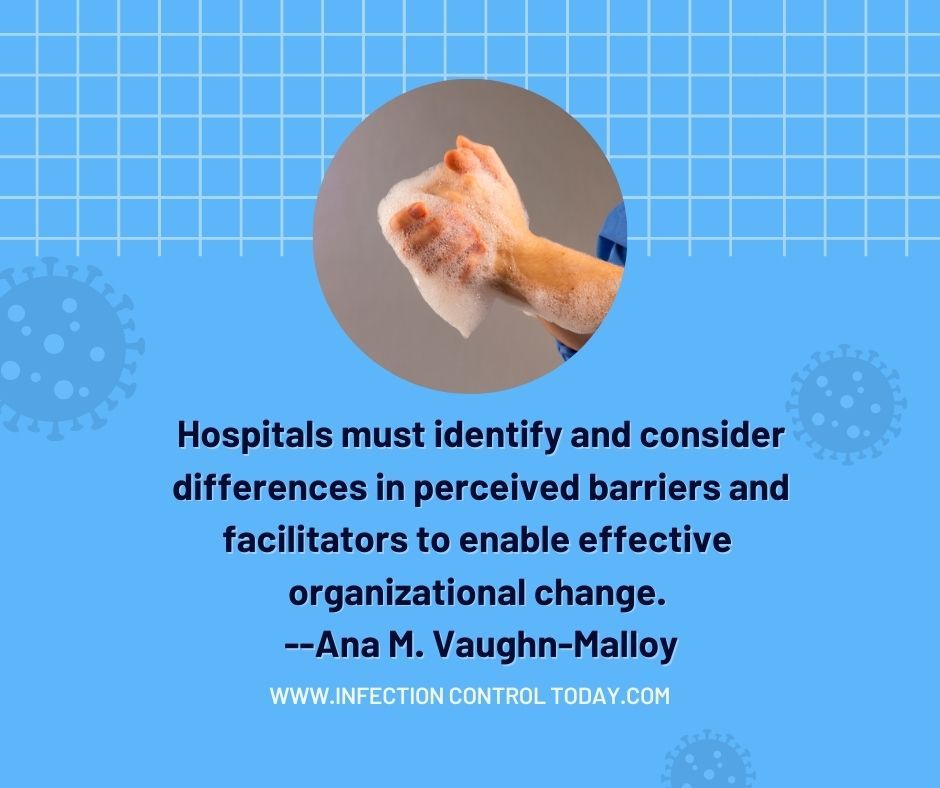Perceptions and Barriers to Hand Hygiene Among Clinician Subgroups
A new study focuses on insights that can be used to create interventions for better hand hygiene adherence among all medical professionals.
Hospitals must identify and consider differences in perceived barriers and facilitators to enable effective organizational change. --Ana M. Vaughn-Malloy

A new study from Boston Children’s Hospital titled “Using a human factors framework to assess clinician perceptions of and barriers to high reliability in hand hygiene,” published in the American Journal of Infection Control (AJIC), highlights the perceptions of and barriers to reliable hand hygiene among specific medical personnel. The study’s results provide insights that, in turn, can be used to design strategies for greater hand hygiene adherence among medical professionals.
Ana M. Vaughan-Malloy, MD, MPH, Associate Hospital Epidemiologist and Associate Medical Director at Boston Children's Hospital, and lead author of this study, answered questions from Infection Control Today® (ICT®) in this exclusive interview.
ICT: A summary of the key findings and why they are important.
Ana M. Vaughan-Malloy, MD: Applying a human factors engineering framework, we surveyed clinicians about perceived barriers and facilitators to performing excellent hand hygiene. We found variability by role (which has been shown before), medical vs. surgical specialties, and career tenure. Since there are few published data about what clinicians view as challenges to sustaining highly reliable hand hygiene, it's essential to recognize that different approaches may be required within different clinician subgroups to best meet our goal.
ICT: What is the practical application for this study's key findings for infection preventionists?
AV-M: Hospitals must identify and consider differences in perceived barriers and facilitators to enable effective organizational change. Infection prevention teams can and should use human factors engineering concepts as a framework to think about and understand clinicians and the things that support (or get in the way of) their work.
ICT: What results surprised you, if any?
AV-M: We were interested in the reported variability between medical and surgical staff in the perception of how often they encounter empty alcohol-based hand rub dispensers and how visible the reminders to perform hand hygiene is in patient care areas, especially since we're not aware of differences in our procedures for refilling dispensers or hanging signage by location across our hospital. Based on these responses, we can monitor more closely to ensure standardization.
ICT: What, if any, future research will there be related to this one?
AV-M: We plan to do a follow-up qualitative study, using focus groups or individual interviews with staff members, to hear more details about the reported challenges (in addition to things we're doing that they really like), as well as to solicit their ideas for how we can continue to make it easier for them to sustain high hand hygiene rates.
ICT: Is there anything else that you would like to add?
AV-M: Hand hygiene is the most essential way to prevent the spread of infections in the hospital, so it's critically important to keep it as a high-priority focus even while we simultaneously tackle many other challenges in health care.
The study can be found here.
The CDC at a Crossroads: Budget Cuts, Public Health, and the Growing Threat of Infectious Diseases
March 12th 2025Budget cuts to the CDC threaten disease surveillance, outbreak response, and public health programs, increasing risks from measles, avian flu, and future pandemics while straining health care infrastructure nationwide.
Standing Up for Science: A Rally Participant’s Perspective
March 11th 2025Infection Control Today's Editorial Advisory Board member and contributing editor, Heather Stoltzfus, MPH, RN, CIC, recently joined the Stand Up for Science rally in Washington, DC. She gives a first-person perspective on the rally and the rally-goers' strong message.